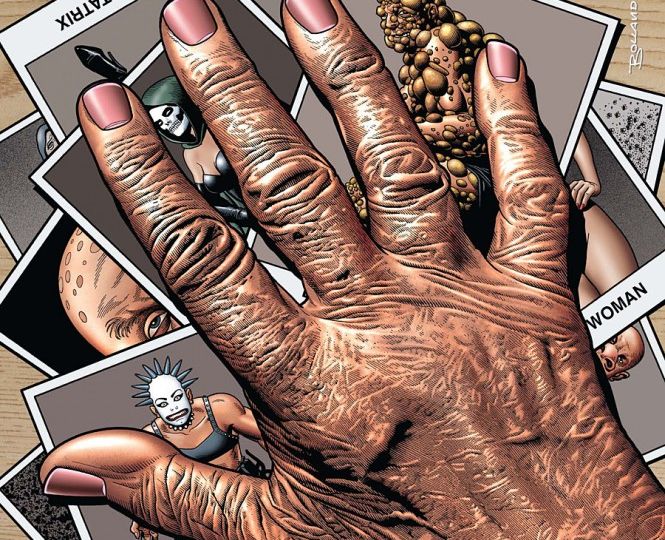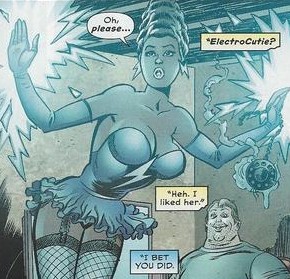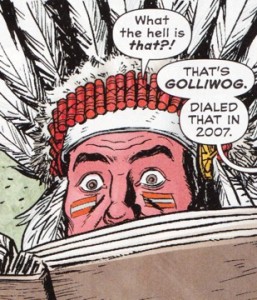
That China Miéville would take on the superhero comic’s most base qualities just six issues into his first ongoing title takes balls. That he does so with deft humor and skill shows he is hitting his stride. That it was drawn by David Lapham*, one of the biggest names in exploitation comics, makes Dial H #6 sublime.
Of course, the seeds were there. In the third issue of the series, Miéville had his sad-sack hero Nelson (an obese thirty-something) react in horror when the Dial transformed him into a super-heroine. This issue, that moment is turned around when Nelson brightens up at his mentor, Roxie (an elderly woman), transforming into a Bettie Boop-esque heroine named ElectroCutie. It’s a wickedly subversive move, calling attention to genre sexism. Nelson’s immediate sensation (“Heh. I liked her.”) overrules his own unease at being turned into a male gaze object, much to Roxie’s annoyance (“I…not being a 13-year old boy, did not.”).
Most of Dial H #6 revolves around discussion of offensive identities the Dial produces. Roxie relates a few, including the racially charged Golliwog (a minstrel-inspired caricature). She rejects these by staying indoors during these transformations. Nelson spends the issue in the form of an “Injun” stereotype named Chief Mighty Arrow, feathered headdress and all, and thinks he should be fighting crime as he is. Lesser writers might have made this the point of a “very special issue”; Miéville resolves it quickly. He guts political incorrectness when Nelson uses broken English, on accident, as Mighty Arrow (“I don’t know where that came from.”). The Dial’s wish-fulfillment properties underlines how stereotypes are ingrained in society, comics culture specifically (Mighty Arrow brings to mind the earliest depiction of Marvel’s American Eagle). Even Roxie, for all her p.c.-ness, can’t escape these ideas, but at least recognizes the error. The various identities (including Dr. Priapus, SS Ilsa, and Kid Torture) connect to themes from the genre’s history, giving historical perspective to Miéville’s script.
Instead of being smartass, indie comic indulgence, Miéville regains the superhero ethos. Nelson’s heroic desire is genuine and admirable: he intends no offense, but that’s the trick to tying bigotry to tradition, isn’t it? The rest of the issue becomes Nelson waiting for a chance to help others, with humor ranging from existential (channel surfing for breaking news) to gross (a Pegasus stopping a hostage situation with its dung).
The latter must have been cathartic for Lapham. He’s used to following his id on comics like Ferals or The Ride: Southern Gothic (in which he depicts murder as sexual climax). Even his corporate work, like Age of Apocalypse, favors it. Here, Miéville limits his use of taboo subject matter mostly to reaction shots and conversation before that moment. Lapham is great at drawing conversations, keeping his characters moving and acting in subtle and hilarious ways. He could probably make the most talky of Bendis scripts as dynamic as a fight scene. However, it is the flying horse that ends up being his best page. It’s a five-panel scene, setting up and averting Nelson’s chance to save the day, steadily building the absurd nature of the televised rescue. Good craft for (ironic) toilet humor.
For being a filler issue, Dial H #6 surprisingly capitalizes on the promise the earlier issues offer. Miéville doesn’t quite translate his stylish prose to the comic script, but instead focuses on ideas. What was once disjointed and unsure becomes precise. With Lapham’s able hand, Miéville shows progress for himself and the cape comic.
*Series regular Mateus Santolouco was erroneously credited on the cover.



















I haven't gotten into Dial H yet….what made you pick it up?
China Mieville, pretty much. His novels are amazing, and I wanted to see what he'd do with superheroes.